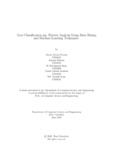| dc.contributor.advisor | Parvez, Mohammad Zavid | |
| dc.contributor.advisor | Rahman, Md Anisur | |
| dc.contributor.author | Ramisa, Aiman Jabeen | |
| dc.contributor.author | Hossain, Ananna | |
| dc.contributor.author | Islam, Sk Md Injamul | |
| dc.contributor.author | Swadesh, Ponuel Mollah | |
| dc.contributor.author | Islam, Md. Toushif | |
| dc.date.accessioned | 2021-10-10T05:05:16Z | |
| dc.date.available | 2021-10-10T05:05:16Z | |
| dc.date.copyright | 2021 | |
| dc.date.issued | 2021-06 | |
| dc.identifier.other | ID 17101012 | |
| dc.identifier.other | ID 17101026 | |
| dc.identifier.other | ID 17101169 | |
| dc.identifier.other | ID 17101299 | |
| dc.identifier.other | ID 17101032 | |
| dc.identifier.uri | http://hdl.handle.net/10361/15185 | |
| dc.description | This thesis is submitted in partial fulfillment of the requirements for the degree of Bachelor of Science in Computer Science and Engineering, 2021. | en_US |
| dc.description | Cataloged from PDF version of thesis. | |
| dc.description | Includes bibliographical references (page 23-25). | |
| dc.description.abstract | Gene classification and pattern extraction from gene sequence data is essential in
understanding different gene sequence features. The field of gene expression data
analysis has grown in the past few years from being purely data-centric to integra tive, aiming at complementing microarray analysis with data and knowledge from
diverse available sources. Since then, it has been used for various science fields,
including the discovery of new drugs, identification of protein coded genes by ana lyzing and separating exons from the main sequence, phenotype prediction based on
gene expression. The paper presents an application of gene classification from gene
sequence data using data mining and machine learning techniques. Our research’s
main goal is to compare different machine learning approaches based on time of
execution, and overall efficiency by testing them on different microarray data sets
of gene sequence and determining the best approach for gene classification. Eight
different machine learning techniques have been tested on eleven different gene ex pression datasets, and the results are compared and improved using the feature
selection method. Moreover, we perform pattern analysis on some gene expression
datasets using a J48 decision tree outcome, after applying feature selection. | en_US |
| dc.description.statementofresponsibility | Aiman Jabeen Ramisa | |
| dc.description.statementofresponsibility | Ananna Hossain | |
| dc.description.statementofresponsibility | Sk Md Injamul Islam | |
| dc.description.statementofresponsibility | Ponuel Mollah Swadesh | |
| dc.description.statementofresponsibility | Md. Toushif Islam | |
| dc.format.extent | 25 pages | |
| dc.language.iso | en | en_US |
| dc.publisher | Brac University | en_US |
| dc.rights | Brac University theses are protected by copyright. They may be viewed from this source for any purpose, but reproduction or distribution in any format is prohibited without written permission. | |
| dc.subject | Classification | en_US |
| dc.subject | Feature Selection | en_US |
| dc.subject | Accuracy | en_US |
| dc.subject | Pattern Extraction | en_US |
| dc.subject | Gene Classification | en_US |
| dc.subject | Application of Machine Learning | en_US |
| dc.subject.lcsh | Machine Learning | |
| dc.subject.lcsh | Data mining | |
| dc.title | Gene classification and pattern analysis using data mining and machine learning techniques | en_US |
| dc.type | Thesis | en_US |
| dc.contributor.department | Department of Computer Science and Engineering, Brac University | |
| dc.description.degree | B. Computer Science | |

